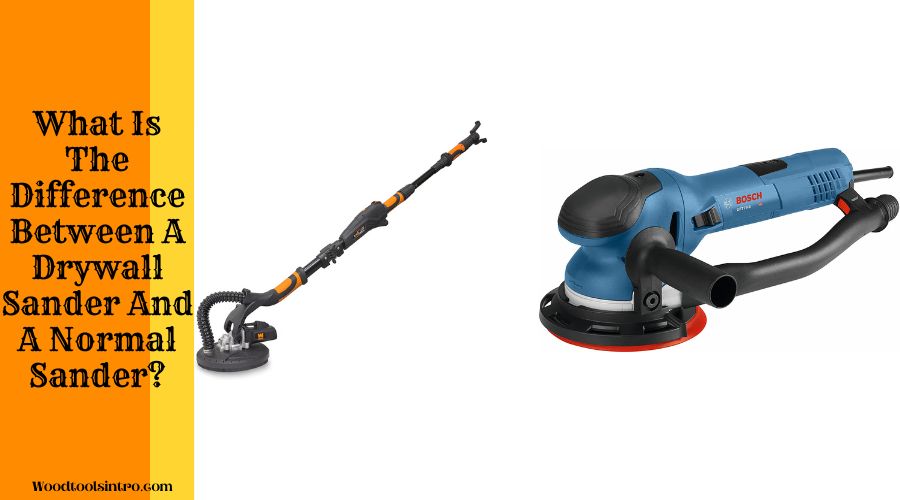Hardwood floors are beautiful, elegant, and easier to clean. They can last an average of 20-30 years with proper maintenance. But they need to be refinished every 05-10 years.
Before painting and refinishing them, appropriately sanding the floor is necessary. But how to sand hardwood floors? Can you drywall sander be used on hardwood floor?
This powerful yet simple tool can help you repair the hardwood floor and give it a perfect look for painting. Keep scrolling to get a complete idea about this topic.
What Is The Difference Between A Drywall Sander And A Normal Sander?

A drywall sander has a larger surface area than a regular random orbital sander. This will significantly cut down the sanding time. You will be able to sand more areas with fewer efforts quickly.
Drywall sanders are mainly suitable for walls, ceilings, wood, etc. People use this easy-to-use tool for grinding softer materials, such as plaster and filler.
Can You Drywall Sander Be Used On Hardwood Floor?
Yes, sanding with a drywall sander on a hardwood floor is okay if you follow the proper method and use the correct grit sandpaper.
Choosing right sized drywall sander is also essential. Generally, small floor areas need a compact handheld drywall sander
But larger hardwood floors need a massive sanding device to minimize the sanding time and make the job easier.
How Can You Use A Drywall Sander On Hardwood Floors?
Sanding a hardwood floor with a drywall sander requires a little practice to achieve a smooth and flawless finish.
Knowing the basic things about sanding and how to use a drywall sander correctly is essential.
You may need to use both coarse and fine grit sandpaper, depending on the condition of your hardwood floor.
How To Sand Hardwood Floor Step-by-step?
Sanding hardwood floors is not a complicated job. But an expert and a newbie don’t sand a surface the same way. That’s why their result varies.
The followings are the essential steps to get a better result from sanding a hardwood floor.
Step: 01—Taking A Well Preparation
Before sanding the hardwood floor, prepare the floor surface properly.
The first job is removing everything sitting on the hardwood floor, such as furniture, electrical devices, and heavy objects.
This will help you access all areas appropriately and sand them uniformly.
Next, clean the hardwood floor by hand or a vacuum cleaner to get off dust, dirt, and debris.
Use a professional wood-cleaning product, such as Bona or Murphy Oil Soap, for effective cleaning.
Wear a respirator mask, safety glasses or goggles, earplugs or earmuffs, gloves, and protective clothing to protect yourself from harmful dust and chemicals.
Step: 02—Setting Up The Drywall Sander
The next job is setting up the drywall sander correctly.
Use a perfect extension cord with the right gauge and length to ensure the sander runs smoothly without any voltage drop or tripping.
Position the sander at a comfortable height to decrease strain on your arms, back, and neck.
Use the appropriate sanding discs that are recommended for the specific sander being used.
Choose a grit size suitable for the job. Most experts recommend using 20 to 80-grit sandpapers for sanding hardwood floors.
Use a dust collection system, such as a vacuum attachment, to reduce dust levels and improve visibility. It will also help prevent dust from settling on surfaces and being inhaled.
Step: 03—Sanding The Hardwood Floor
Use circular motions while sanding the hardwood floors using a drywall sander.
It prevents grits or fine particles from passing over the same spot repeatedly. This leaves a better finish.
Don’t sand the hard floor with a linear motion. Otherwise, it damages wood fibers on the floor.
Avoid putting excessive force on any side of the sander’s disc. It may cause the disc to bend or warp.
The floor may also have scratches, dents, or shallow gouges from excessive pressure. Repairing these deep dents and scratches on hardwood floors might not be challenging.
Additionally, overlap each sanding pass by about 50% to eliminate uneven sanding and smooth out imperfections. It also prevents any noticeable edges or ridges
Also, change the discs regularly to ensure they are not worn out, which can reduce the effectiveness of the sander.
Step: 04—Inspecting And Cleaning The Sanding Area
Once you are done with the sanding, cross-check all spots to ensure all areas are evenly sanded.
Now, use a vacuum or a Hoover to clean the entire hardwood floor properly. Go for several rounds to ensure nothing is left on the floor surface.
Again, check the entire hardwood floor carefully before applying the paint. If any nooks or corners need any repair, do it immediately.
Finally, take a plastic bag and put down all the waste materials into it. Keep the bag inside the dustbin.
Advantage Of Drywall Sanders
- Drywall sanders have a larger surface area to cover more space quickly.
- This sanding device offers better dust control as it leaves minimal dust behind.
- Adjusting the speed of a drywall sander is simple to suit various working requirements.
- It is flexible, as many come with a telescopic handle or a detachable brush rim edge.
- Drywall sanders are foldable to save space while storing them.
Disadvantages Of Drywall Sanders
- If you use drywall sanders frequently, replacing the motor’s carbon brushes from time to time is necessary.
- Their flexible drive cables may show premature failure issues sometimes.
- Drywall sanders can be pretty loud.
What To Focus When Using Drywall Sander On Hardwood Floor?
If you have not sanded any hardwood floor with a drywall sander in the past, it might be a bit complicated to perform the job.
It is better to practice it on an unnecessary wood object several times to get used to it. Your sanding skill and technique determine how good the outcome will be.
Your sanding pattern must be consistent. Using long, overlapping strokes and sanding at a consistent angle is necessary.
Sanding Hardwood Floor Common Mistakes & How To Avoid Them
01. Avoid using incorrect grit sandpaper. Depending on the hardwood floor condition, it ranges from 20 to 80 grit.
02. You don’t want the hardwood floor to be too less or too much. Perfect sanding will provide a smooth finish.
03. Don’t use the same sandpaper for too long. Change it frequently to achieve an ideal result.
04. Avoid sanding the edges of the hardwood floor as much as other areas.
Last Words
Using a drywall sander to sand hardwood floors is not a problem if you follow the proper techniques and use the correct items for smooth sanding.
Make sure to inspect your hardwood floor condition before starting sanding. Also, be cautious while sanding the floor to avoid overdoing it.
Hopefully, you got a clear answer to the question, “Can you drywall sander be used on hardwood floor?” Sand cautiously and give your floor surface a new attractive look.

I am Imtiaj Islam. I am a wood working enthusiast, having 6 years of experience in carpentry work. I have a BBA graduate degree from Chittagong College. I got vocational training on wood works from Korean Polytechnic out of the quest and zest he has for carpentry as well. I take several wood projects and keep testing different woodworking tools for comfortable and perfect work. I just love playing with woods and machines.
